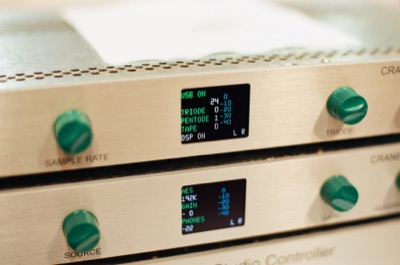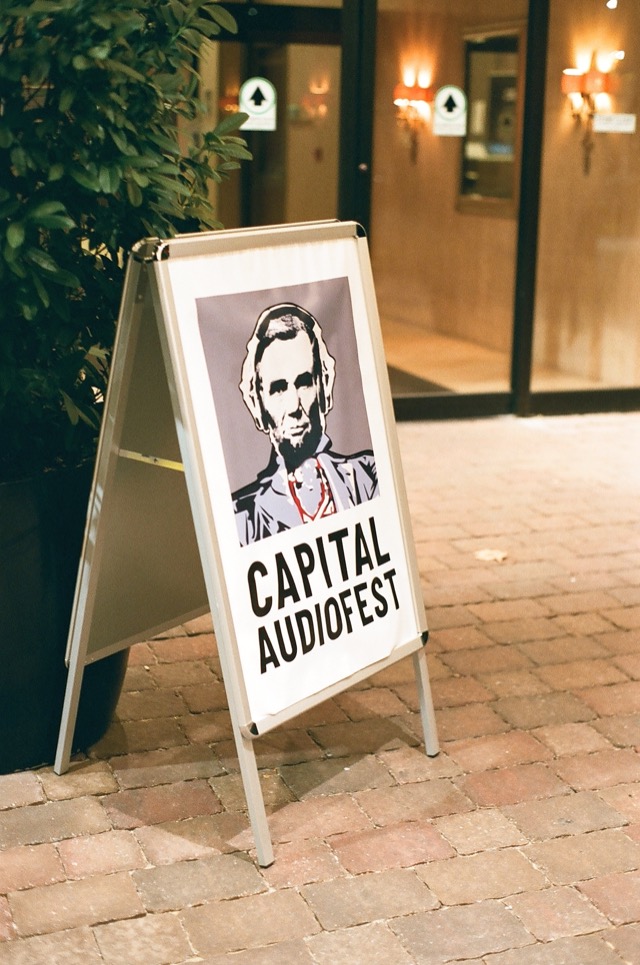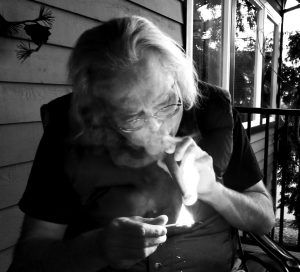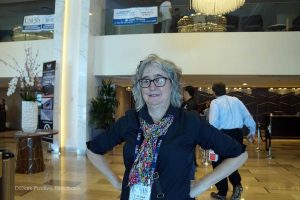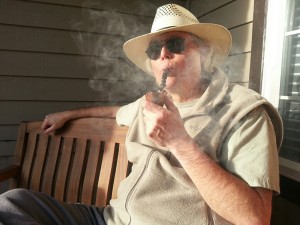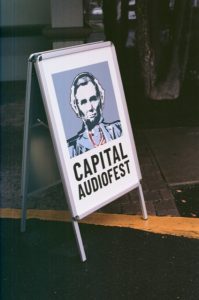This year's European AES show was in Dublin, which seemed a bit of an odd choice for a location because there is not a huge audio production community there. So the show was small, but it was interesting because the people who did show up were dedicated folks.
Room Treatment
Usually at the US shows you see a huge number of dealers with booths, but Ireland is a small country and there is really only one pro audio dealer serving the whole of Ireland. Big Bear Sound Limited had a variety of products on display from their dealership but what was most interesting to me was a line of acoustical treatment products from a Portuguese company called Vicoustic. They had a very spiffy and modern-looking panel that provides absorption and diffusion as well as some bass absorption, called the Wave Wood, some wood/foam structures called Flexi Wave which provide diffusion and some bass control, as well as more conventional and common acoustical control products. Nice looking materials that you won't see in the US market yet.
Another Irish company, Smart Studio, has a really ingenious system where they draw out diffusion panels, wall modules, and some studio furniture on a CAD model of the room, and then they are automatically fabricated by CNC routers that cut wood to shape. The modules are assembled off-site and then the actual on-site studio setup is extremely rapid. They claim this process reduces costs as much as 30% over using conventional treatments. This would be just as good a plan for a home listening room as for a major studio. Currently they are doing work only within the UK and EU but they are looking at expanding into the North American market. Jim Dunne from the company also presented an E-Brief as "Room and Architectural Acoustics - A New Approach to the Design and Delivery of Critical Studio Facilities" as E-Brief 496.
Bezal John Benny and Kirk McNally talked about the "University of Victoria Sound Recording Studio Renovation. This is the kind of case study paper that used to be common at the AES. This sort of thing is important not just to show others what practices are commonly followed in studio design, but a century from now it will be a valuable document showing what practices were followed in the early 21st century. There is nothing innovative here, it's just a great description of how a studio was renovated and what design decisions went into how it was done. Convention paper 10151.
Microphones
Not a lot of microphones on the show floor but the UK distributor for Microtech Gefell was showing off their M102. I think this is likely the most exciting product I saw at the show, being an adaption of their M231 microphone set up to use a 1" measurement microphone capsule. This capsule is omnidirectional but with some beaminess at high frequencies that isn't present in the smaller one used in the M231. That beaminess makes it a great choice for use with a Jecklin Disc for orchestral recording because you can adjust the high end image width easily by shifting the microphone angles slightly. It's very close to the modified B&K system that I have used for years but more convenient in every way.
Whereas conventional condenser microphones measure charge across the capsule, some RF microphones have used oscillators and tuned circuits set up so that the change in capsule capacitance changes phase or amplitude of a radio signal which can then be detected. Lars Urbansky and Udo Zoelzer from Helmut-Schmidt University in Hamburg built such a device, but using an RF A/D and a digital processor in order to extract the data. In "A Novel Digital Radio-Frequency Capacitor Microphone with Gain Ranging" they described the method. They used amplitude modulation of a synthesized RF signal by the capsule going into a high speed A/D. This method seems much more cumbersome than frequency or phase modulation where the waveform linearity is no longer critical, but the authors seemed to like the amplitude approach and gave this presentation in preparation for actually building such a device. Convention paper 10214.
Ultrasonics
One paper that shows just how diverse the research discussed at the AES is would be "Configuration for testing Intermodulation of Ultrasonic Signals in the Microphone Path" by Dominic Stanczak and others at Intel in Poland. They are worried about communications security, and what they call the "Dolphin Attack" where multiple ultrasonic signals directed at a microphone cause intermodulation inside the microphone and the pickup of foreign audio signals that might not be heard by the human ear. They tried several different excitation configurations until they found an effective one that worked with inexpensive condenser microphones. E-Brief 505.
On the opposite side of the ultrasonic world, Jose Calavid and Antonin Novak talked on "Practical problems in building parametric loudspeakers with ultrasonic piezoelectric emitters." These folks want to use even higher levels of ultrasonics to create actual sound due to the nonlinearity of air. To do so, they want to use inexpensive piezoelectric ultrasonic emitters and so they make measurements on a series of them to find that all the ones tested are very nonlinear and even more alarmingly many of them are shipped with completely random polarity. This is interesting work because it shows how much more is needed. Convention Paper 10145.
Surround
People use microphones to record things! In "Comparison of recording techniques for 3D audio due to difference between listening positions and microphone arrays", Toru Kamekawa and Atsushi Maru from the Tokyo University of the Arts described several arrays for recording multichannel audio with height cues. They made recordings, played them back, and had listeners select how they felt each recording sounded using a list of sonic attributes. The microphone configurations they selected included some peculiar ones like a "hedgehog" array of shotgun microphones, but the results made sense. This paper is worth checking out if only because it is a very fine example of how to conduct a repeatable listening test. Convention Paper 10136.
On a very different subject, Maksims Mironovs and Hyunkook Lee from the Applied Psychoacoustics Lab at the University of Huddersfield talked on "Localization of natural sound sources at various azimuth and elevation angles." We all talk about pinpoint imaging, but in the real world how accurately can we image sources? These folks found that both perceived height and azimuth were affected substantially by pitch. Is this the result of the room cues? Is this the result entirely of the brain? This paper is great because it opens up so many questions. E-Brief 10165.
Radio
The UK dealer for Gefell, Sound-Link, also was selling audio codecs from AETA. These are boxes that allow point-to-point audio transmission over the public switched internet for live broadcast, and I was amazed to see how much better the sound quality of these devices has improved in recent years. European radio people care about sound quality and there is far less abuse of compression than is heard in the US.
I talked a bit to the folks from Orban, manufacturer of dynamic processing gear for radio, and they talked a bit about this and about how they made equipment that could be set up very cleanly for the European market but that what European and American broadcasters wanted was so different. Software control today, though, allows both of these sets of demands to be satisfied with one box.
Speakers
Outline, a company from Italy, was showing a line of small sound reinforcement speakers in various configurations for portable use.
Back in the fifties, many dedicated hi-fi enthusiasts installed enormous low frequency horns in their room because at the time the theory for designing accurate vented boxes didn't exist. Even when good vented boxes came around, many of these folks persisted, claiming that the response across the room was more consistent with the enormous external horn ducted into the room. It turns out they were right. In "Large Horns and Small Rooms - Do they 'Play Nicely' Together?", Bjorn Kolbrek from Celestion sets up a simple mathematical model of the bass horn, demonstrates that the on-axis behaviour matches that of the real thing, and then shows smoother response across the room, presumably because it is exciting more room modes at the same time and therefore we don't wind up with a few modes dominating the response plot. This should not be enough to cause you to demolish your dining room and install a horn, but it's interesting to see arguments from three-quarters of a century ago finally resolved. Convention Paper 10132.
Higher frequency horn speakers involving compression drivers are a different issue. These have hidden sources of nonlinear distortion, both because of the nonlinearity of the compression drive and the nonlinear compressibility of air in the high-pressure throat of the horn. How can we measure this distortion in a useful way that correlates with audible effects and is repeatable. In "Comparison of Horn Drivers' Nonlinear Distortion Measured by Different Methods," Balasz Kakonyi presented a paper he'd written with Alexander Voishvillo and Brian McLaughlin where they compared different types of measurements (multitone and swept sine) measured in different ways. Their goal was to provide a set of measurements that they could later compare with subjective listening tests in a future paper. E-Brief 516.
Juha Backman from Huawei spoke on "Dynamic Driver current feedback methods". For many years people have been looking at current drive as a way to control driver response but utility has been very limited. In this paper, he describes a method where current feedback allows an amplifier to have a source impedance that varies with frequency. If the filter, amplifier, and speaker are all designed together, this gives the designer a tool that can reduce distortion and thermal compression as well as being used to tailor response. Convention Paper 10152.
And, in "Impact of the Coupling Factor on Lossy Voice Coil Impedance," Isao Anazawa talked about one of the less understood causes of speaker distortion. When current flows through the voice coil, it induces eddy currents in the metal supporting members and the magnet, and that affects the speaker impedance and reduces efficiency. The conventional model of such losses says that they will be proportional to the square root of the frequency, but in fact they are worse at some frequencies and the author sets forth an improved model and shows that it better represents the behavior of actual loudspeakers. Convention paper 10153.
Headphones
High end headphones have become a huge market, as many younger people are getting interested in finally having good quality audio but have grown up with headphones on.
Amoenus Audio is selling a device called the Authentic Stereo Monitor, which attempts to model an average HRTF, so that audio run into the box and listened to with headphones sounds like it's coming from a speaker system. It doesn't do any room simulation, so it's still just as dry, but the sense of the sound coming from in front of you instead of inside the head is fairly effective. If you have been interested in shuffler boxes in the past, this is a step up from any of those conventional methods in terms of getting effective and accurate headphone playback of recordings made for speakers.
In "Segmentation of Listeners Base on their Preferred Headphone Sound Quality Profiles", Sean Olive and others from Harman International took results from two controlled listening tests where listeners gave ratings for headphones. They had found that listeners overall preferred headphones that approximated the Harman International target curves. In this paper, they reanalyzed the data from those previous papers using cluster analysis. They found that listeners fell into three basic categories: people who liked a lot of bass, people who liked recessed bass but more treble, and people who liked the target curve. Age and sex correlated with these groups somewhat, but listening experience didn't. This was an interesting paper in how they classified listeners. Convention paper 10156.
Signal Processing
Jamie Howarth from Plangent Processes was there, talking about his process where bias leakage is extracted from original master tapes and then used to correct speed variations in recording. This is the -only- real way to effectively eliminate small amounts of flutter in older analogue recordings and its effect to sharpen up imaging is amazing. I know I have been writing about this for a decade now and it's increasingly being used by remastering folks, so this is not a new thing in any way, but it's still exciting.
A company called Second Sound is introducing an interesting ASIC which is a mix of digital and analogue hardware that extracts a MIDI stream from audio in real-time. It's not perfect, but it can handle some remarkably strange chords accurately. Brian Kaczynski was at the show attempting to interest manufacturers into integrating his chip into their product. With something like this it's not hard to have a guitar with an integrated MIDI output right in the body, for instance. These folks also have a full line of other interesting integrated circuits that look to be aimed at synth and instrument designers.
In "Primary study on removing mains hum from recordings by active tone cancellation algorithms," Michal Luczynski describes the conventional algorithm where a noise signal is synthesized with reference to an audio sample and then that noise is inverted and removed from the sample. Similar variations on this are used by many noise removal packages but in this paper he measures the actual effectiveness of the algorithm and shows where it works and where it may break down. Convention paper 10147.
Andrew Stanford-Jason gave a great tutorial titled "LTI Filter Design and Implementation 101" which went into a lot of detail about how to get good performance out of digital filters with limited computing power, and where some of the quality pitfalls in filter design lie. It was a great thing for students and academics who may have seen the theory in great detail but benefited a lot from details on actual real-world implementations.
Converters
Crane Song was showing their Interstellar A/D converter. It's a simple box like everyone's elses but these folks spent an incredible amount of effort getting sub-picosecond jitter on the master clock. USB, AES/EBU, and S/PDIF interfaces all available on the back, and conversion up to 192 ksamp/sec. And, unlike some other converters, the performance is as good at 192 as it is at lower sample rates.
Also on the high end, Prism was showing their Lyra USB interface which provides A/D and D/A conversion with an accurate internal clock and common USB interfaces right to your computer. Prism is one of the longstanding manufacturers of high end converters and has been around since the eighties in both the pro-audio and high-end markets.
Presonus was showing an affordable 1U box called the Quantum, with six channels of A/D and D/A and Thunderbolt and ADAT Lightpipe interfaces. No processing, no resampling, just straight through. And yes, you can lock it to a precision external clock.
Jamie Angus from the University of Salford has long been doing interesting work on digital audio, and in "Applying Modern Sampling Methods to the Mastering Process for Digitally Recorded Material" she brought up a fascinating point. Sample rate converters consist of a filter to average signals in such a way that the output has fewer samples than the input, but they are effectively doing the same thing as any other sharp digital low-pass filter. If you want a sharp filter without considerable artifacts it takes infinite time. In the real world, applying such a filter over a fixed-length file can take a finite but extremely long time, so normally we make considerable compromises in the filters for these algorithms. But, with general purpose computers being so fast and cheap, how long does it really take? Dr. Angus was able to resample a five minute song in an hour and a half on a desktop computer, which really isn't bad. This is fast enough that for audiophile applications where sound quality is paramount and you can wait a few days for result, there really is no reason to do anything else. Convention Paper 10176.
Another paper that didn't look like it was going to be interesting but turned out to be very remarkable was Akira Nishimura's "Prediction of least significant bits from upper bits in linearly quantized audio waveform." When information is lost in the digitization process, it is lost forever and it cannot ever be derived from the original signal. But, we can make a good guess about what it probably was, and in the past this has made things like clipping reconstruction algorithms possible. In this case, the author is doing the exact opposite, trying to reconstruct low level details that were lost rather than high level ones. This may be of great interest for archivists dealing with recordings of limited resolution from the early days of digital recording. Convention paper 10179.
Magazines
I didn't see any other reporters there and the only magazine folks I saw were from the British magazine Resolution. This is a terrible shame because this is a show that deserves more publicity.
Other Stuff
IMRO was there. The Irish Music Rights Organization is more or less like ASCP and BMI in the US, collecting public performance royalties and distributing them to music authors. It's good to see folks like this coming out to conferences just to show that they exist, especially for people abroad who might not know that things are done differently in different countries.
Fedrica Bressan gave a paper that was authored by Ana Paula da Costa Ribeiro, Teresa Rosa and herself, on "Early causes for biodegradation of PVA/PVC tapes for audio recording" in which there was some description of dechlorination of PVC materials causing lowered pH. Convention paper 10158.
Toshihiko Hamasaki and others from the Hiroshima Institute of Technology took an assortment of different 12AX7 tubes, measured curves, and worked out the various parameters to model them using a standard SPICE model that relies on an electrostatic model of the physical tube. They then had a database of such parameters that they could use to compare differences between tubes of different manufacturers as well as tubes of the same manufacturer by using cluster analysis. In "Statistical analysis of audio triode tube properties based on an advanced physical device model" they found some manufacturers more consistent than others and that different manufacturers often had very different characteristics. This is something any modern tube customer likely knows but it's good to see it demonstrated. Convention Paper 10213.
Sean Davies gave a great tutorial titled "Recording Irish Music." This was just an overview of the history of recorded Irish music, starting from Irish expatriates recording in New York on through Michael Gorman, John Doherty the great fiddler from Donegal, and the McPeakes family band. It was great fun just sitting back and listening to his recordings and listening to his notes about each one, and a pleasant change from the pace of the rest of the convention.
There was also an interesting workshop on Media Preservation and Recovery with Brad McCoy, Federica Bressan, and Alex Tomlin, talking about some of the experiences they have all had with damaged media over the years.
I missed the workshop on "Dance Music Training - The Unregulated Industry and CPD - Analytical Listening Skills." I find electronic dance music difficult to listen to, maybe because I don't know how to listen to it and any discussion applying critical analytic listening to EDM sounds like it could be interesting. Unfortunately it was programmed against two other interesting items.
I did make it to a technical tour on Church Acoustics and Sonic Heritage where we all got to go out to the Trinity College Chapel which is very interesting because it was designed for use by both Catholic and Protestant services. This makes for some interesting layout that you would not see in most traditional European churches. We then got a great discussion about the room and its acoustics and an example of measuring impulse response of the room.
Conclusion
The AES show is always interesting and although there wasn't as much of great interest to the high end world at the European show this spring, there's a show in New York coming soon.









